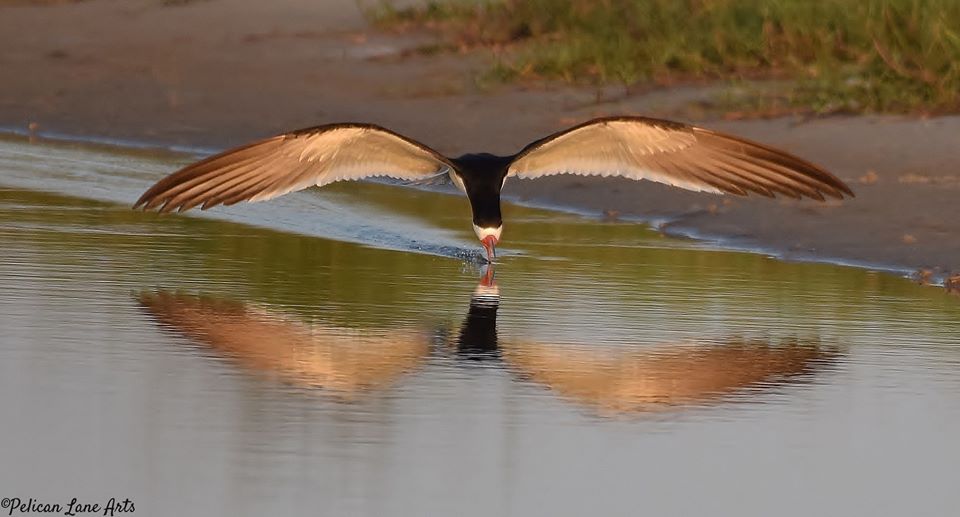
by Chris Verlinde | May 1, 2020
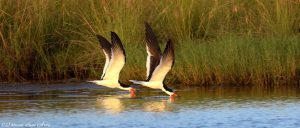
Black Skimmers foraging for fish. Photo Credit: Jan Trzepacz, Pelican Lane Arts.
Black Skimmers and Least Terns, state listed species of seabirds, have returned along the coastal areas of the northern Gulf of Mexico! These colorful, dynamic birds are fun to watch, which can be done without disturbing the them.
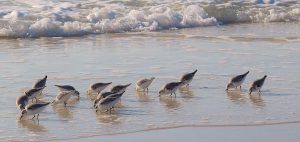
Shorebirds foraging. Photo Credit: Jan Trzepacz, Pelican Lane Arts.
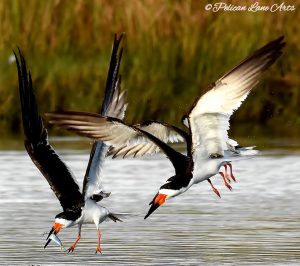
Black Skimmer with a fish. Photo Credit: Jan Trzepacz, Pelican Lane Arts.
What is the difference between a seabird and shorebird?
Among other behaviors, their foraging habits are the easiest way to distinguish between the two. The seabirds depend on the open water to forage on fish and small invertebrates. The shorebirds are the camouflaged birds that can found along the shore, using their specialized beaks to poke in the sandy areas to forage for invertebrates.
Both seabirds and shorebirds nest on our local beaches, spoil islands, and artificial habitats such as gravel rooftops. Many of these birds are listed as endangered or threatened species by state and federal agencies.
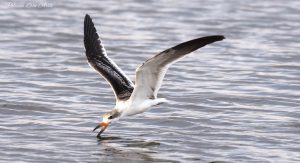
Juvenile Black Skimmer learning to forage. Photo Credit: Jan Trzepacz, Pelican Lane Arts.
Adult black skimmers are easily identified by their long, black and orange bills, black upper body and white underside. They are most active in the early morning and evening while feeding. You can watch them swoop and skim along the water at many locations along the Gulf Coast. Watch for their tell-tale skimming as they skim the surface of the water with their beaks open, foraging for small fish and invertebrates. The lower mandible (beak) is longer than the upper mandible, this adaptation allows these birds to be efficient at catching their prey.
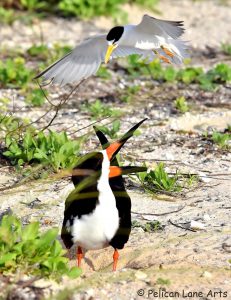
Least Tern “dive bombing” a Black Skimmer that is too close to the Least Tern nest. Photo Credit: Jan Trzepacz, Pelican Lane Arts.
Adult breeding least terns are much smaller birds with a white underside and a grey-upper body. Their bill is yellow, they have a white forehead and a black stripe across their eyes. Just above the tail feathers, there are two dark primary feathers that appear to look like a black tip at the back end of the bird. Terns feed by diving down to the water to grab their prey. They also use this “dive-bombing” technique to ward off predators, pets and humans from their nests, eggs and chicks.
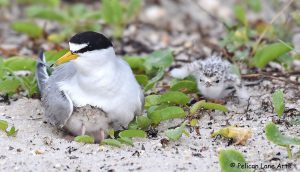
Least Tern with chicks. Photo Credit: Jan Trzepacz, Pelican Lane Arts.
Both Black Skimmers and Least Terns nest in colonies, which means they nest with many other birds. Black skimmers and Least Terns nest in sandy areas along the beach. They create a “scrape” in the sand. The birds lay their eggs in the shallow depression, the eggs blend into the beach sand and are very hard to see by humans and predators. In order to avoid disturbing the birds when they are sitting on their nests, known nesting areas are temporarily roped off by Audubon and/or Florida Fish and Wildlife Conservation Commission (FWC) representatives. This is done to protect the birds while they are nesting, caring for the babies and as the babies begin to learn to fly and forage for themselves.
Threats to these beautiful acrobats include loss of habitat, which means less space for the birds to rest, nest and forage. Disturbances from human caused activities such as:
- walking through nesting grounds
- allowing pets to run off-leash in nesting areas
- feral cats and other predators
- litter
- driving on the beach
- fireworks and other loud noises
Audubon and FWC rope-off nesting areas to protect the birds, their eggs and chicks. These nesting areas have signage asking visitors to stay out of nesting zones, so the chicks have a better chance of surviving. When a bird is disturbed off their nest, there is increased vulnerability to predators, heat and the parents may not return to the nest.
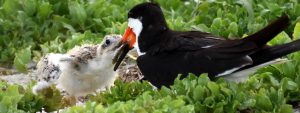
Black Skimmer feeding a chick. Photo Credit: Jan Trzepacz, Pelican Lane Arts.
To observe these birds, stay a safe distance away, zoom in with a telescope, phone, camera or binoculars, you may see a fluffy little chick! Let’s all work to give the birds some space.
Special thanks to Jan Trzepacz of Pelican Lane Arts for the use of these beautiful photos.
To learn about the Audubon Shorebird program on Navarre Beach, FL check out the Relax on Navarre Beach Facebook webinar presentation by Caroline Stahala, Audubon Western Florida Panhandle Shorebird Program Coordinator:
In some areas these birds nest close to the road. These areas have temporarily reduced speed limits, please drive the speed limit to avoid hitting a chick. If you are interested in receiving a “chick magnet” for your car, 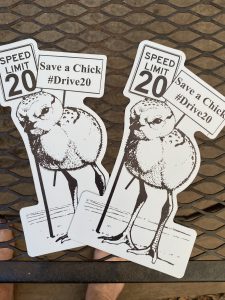 to show you support bird conservation, please send an email to: chrismv@ufl.edu, Please put “chick magnet” in the subject line. Please allow 2 weeks to receive your magnet in the mail. Limited quantities available.
to show you support bird conservation, please send an email to: chrismv@ufl.edu, Please put “chick magnet” in the subject line. Please allow 2 weeks to receive your magnet in the mail. Limited quantities available.
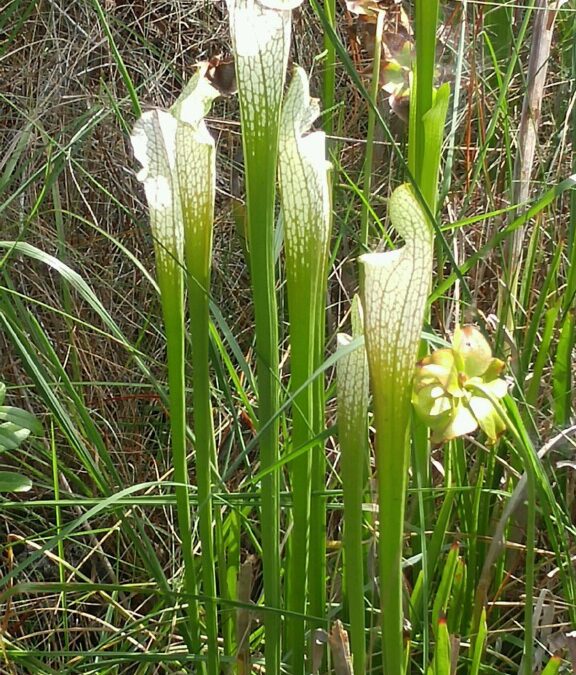
by Carrie Stevenson | Apr 30, 2020
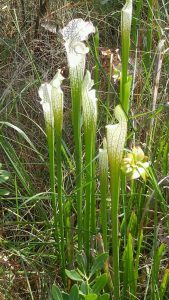
White-topped pitcher plants in bloom at Tarkiln State Preserve. Photo credit: Carrie Stevenson, UF IFAS Extension
If you live in northwest Florida or southeast Alabama and have never laid eyes on our wild native carnivorous plants, it is about time! April and early May are the best time to see them in bloom. We have six species of pitcher plants (Sarracenia), the most common being the white-topped (Sarracenia leucophylla). However, they come in multiple colors, from yellow and red to a deep purple, and in different sizes.
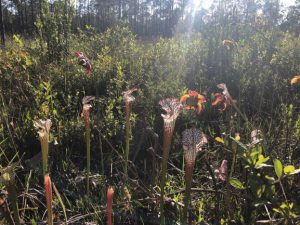
Pitcher plants and their pinwheel-shaped flowers at Splinter Hill Bog. Photo credit: Carrie Stevenson, UF IFAS Extension
One thing they have in common, though—they eat meat. Carnivorous plants all over the world have evolved in places that left them few other options for survival. These plants are typically found in extremely wet, acidic, mucky soils with very low nutrient levels. Normally, plants uptake nutrients like nitrogen and phosphorus from the soil around them. Not being available in these particular environments, carnivorous plants (or more specifically, insectivorous) developed a way to extract nutrients from insects.
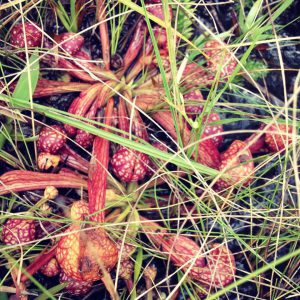
Small parrot pitcher plants lie on the ground instead of standing upright at Blackwater State Forest. Photo credit: Carrie Stevenson, UF IFAS Extension
So how does it work? Pitcher plants have a modified leaf, which instead of lying out flat like most plants, is rolled up into a tube, or “pitcher” shape. The inside of the pitcher has a sweet sap, and the walls of the tube are lined with tiny, downward-pointing hairs. Separate from the leaf, the plant has an elaborate flower structure, which attracts insects for pollination. While nearby, these insects are also attracted to the colorful leaf and the sweet sap in its pitcher. The insect will land on the lip of the leaf, then crawl down.
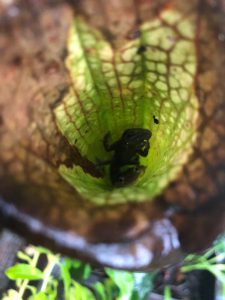 Those sticky, downward facing hairs are a trap, preventing insects from leaving the pitcher. Enzymes—a cocktail of proteins naturally found in many other plants but used creatively here—in the sap break down the bug bodies and convert them to nutrients for the plant. In fact, if you slice a cross-section into a pitcher wall or break open a dried one, you will see countless dried exoskeletons at the bottom of the tube. Several other enterprising species have taken advantage of the pitcher plant’s creative structure. More than once, I have seen tiny spiders spin webs across the mouth of the tube, or small lizards and frogs at the bottom, waiting patiently for prey.
Those sticky, downward facing hairs are a trap, preventing insects from leaving the pitcher. Enzymes—a cocktail of proteins naturally found in many other plants but used creatively here—in the sap break down the bug bodies and convert them to nutrients for the plant. In fact, if you slice a cross-section into a pitcher wall or break open a dried one, you will see countless dried exoskeletons at the bottom of the tube. Several other enterprising species have taken advantage of the pitcher plant’s creative structure. More than once, I have seen tiny spiders spin webs across the mouth of the tube, or small lizards and frogs at the bottom, waiting patiently for prey.
Some of the best places to see pitcher plants in the area—they also bloom in October—are Tarkiln Bayou State Preserve, Weeks Bay National Estuarine Research Reserve, Splinter Hill Bog Preserve, and Blackwater State Forest.
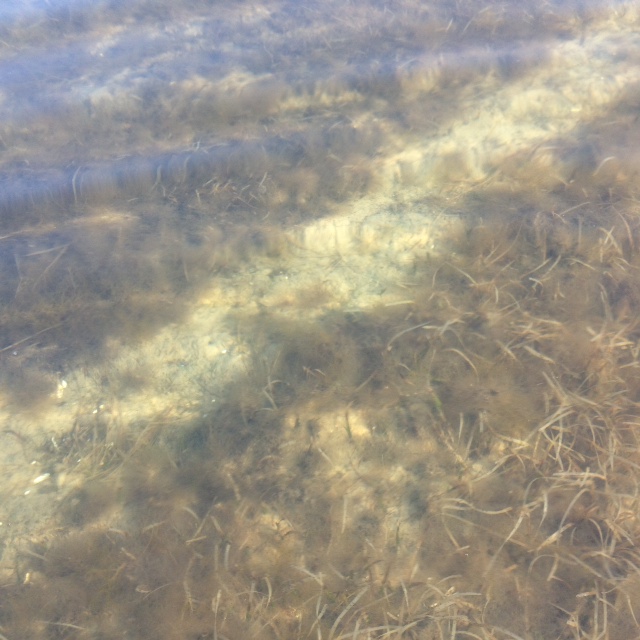
by Chris Verlinde | Feb 28, 2020
What’s the big deal about seagrasses?
Seagrass meadows are made up of plants that live under water in our local estuaries. Just like the grass and plants in our yards where many types of insects, worms and small animals live, seagrass meadows provide habitat for many types of young fish and invertebrates, such as crabs and shrimp.
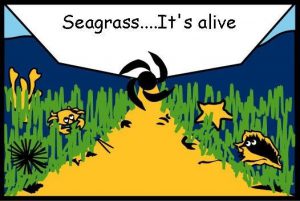
Between 70 and 90% of fish, crabs and shrimp that recreational and commercial fishermen catch, spend some time during their life in seagrass beds. In 2014, the commercial fishing industry contributed nearly $140 million, while recreational fishing spending contributed $6 billion to Florida’s Economy. If we did not have healthy seagrasses, we would not have this economic impact on our coastal economies (http://gulffishinfo.org/Gulf-Fisheries-Economics).
In addition:
· As seagrass blades move with the currents and tides, sediments are removed from the water, which contributes to improved water clarity.
· Seagrasses are the same type of plants that grow on land, they produce oxygen for marine life.
· Seagrasses filter excess nutrients from the water.
· Provide food and shelter for juvenile fish, shrimp and crabs.
· Endangered species such as manatees and green sea turtles depend on seagrass beds for food.
· Migratory birds depend on seagrass beds for foraging needs.
What can you do to help protect seagrasses?
While boating:
• Avoid seagrass beds. If you do run aground in a seagrass bed, turn off your engine, tilt up the engine and walk or pole your boat out of the shallow water.
• Be safe and know water depths and locations of seagrass beds by studying navigational charts.
• Seagrasses are usually found in shallow water and appear as dark spots or patches. Wear polarized sunglasses (to reduce glare) to help locate these areas.
• Always choose to use a pump-out station for your marine sanitation device.
• Stay in marked channels.
At home:
• To reduce pollution from entering our waterways, keep a buffer of native plants along your shoreline. This will also help to protect your property from erosion and slow flood waters during storm events.
• To save money, plant native plants that don’t require a lot of fertilizers and pesticides. Avoid seagrass beds when planning for dredging activities or pier construction.
• Comply with Shoreline Protection construction codes
• Maintain septic tanks.
In your community:
• Families and children can get out and snorkel these areas! Many sites are easy to access from public parks.
• Get involved with local organizations that promote nature protection.
• Working together, we can share with community members what we have learned about seagrasses at the 20th annual Seagrass Awareness Celebration, March 6, 2020 from noon until 4 pm at Shoreline Park South in Gulf Breeze Fl.
• Don’t litter!
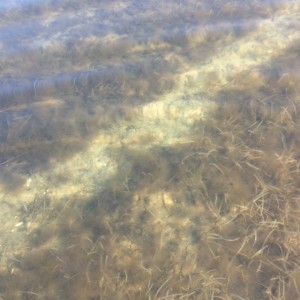
The scarring of seagrass but a propeller.
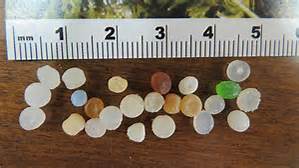
by Rick O'Connor | Sep 6, 2019
It is an amazing product actually… plastic. It can be molded into all sorts of shapes and forms. In some cases, it can be more durable than other products, it is lighter and cheaper than many. Slowly over time, we began to use more and more of it. I remember as a kid in the ‘60s Tupperware products were common. Cups and bowls with resealable lids. Coffee cups followed, then 2-Liter coke bottles, to the common water bottle we see today. As I look around the room, I am in right now there are plastic pens, picture frames, suntan lotion bottles, power cords, rain jacket, the cover and keyboard of this laptop. Plastic is part of our lives.
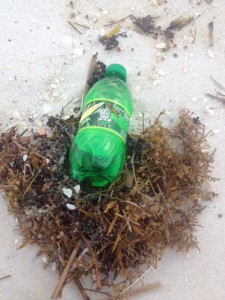
A variety of plastics ends up in the Gulf. Each is a potential problem for marine life. Photo: Rick O’Connor
Unfortunately, being relatively inexpensive, it is also easily disposed of. Many forms of plastic are one-time use. In some cases, we purchase and discard them without really using them – plastic wrap covering fruit, or the famous plastic grocery bags. Most of this discarded plastic eventually finds its way into the environment. Data from the 2017 International Coastal Clean Up, showed that globally all the top 10 items collected were plastic. Most of it was cigarette butts and items related to food and drink. Even with all the press, the number of plastic grocery bags collected actually increased. One study conducted in 2015 estimated the amount of plastic in our oceans would be enough to fill 5 plastic grocery bags for each foot of shoreline of the 192 countries they surveyed.
There is a lot of plastic out there. One researcher commented… it’s all still there. Some have estimated that plastic takes about 600 years to completely break down. Plastic items degrade while exposed to sun, sand, and saltwater. But they never go away. They become smaller and smaller to a point where you cannot even see them anymore – these are called MICROPLASTICS.
Microplastics are defined as any plastic items 5mm or smaller in diameter. Most plastics float, and most microplastics float as well, but pieces of microplastics have been found throughout the water column and even in the deep-sea sediments. They come in two forms; primary and secondary.

“Nurdle” are primary microplastics that are produced to stuff toys and can be melt down to produce other products.
Photo: Maia McGuire
Primary microplastics are plastics that are produced at these small sizes. All plastic products begin as small beads called nurdles. Nurdles are produced and shipped to manufacturing centers where they are melted down and placed into forms which produce car bumpers, notebook covers, and water bottles. Many of these nurdles are shipped via containers and spills occur. Other primary microplastics are microbeads. These are used in shampoo, toothpaste, and other products to make them sparkle, or add color. As they are washed down our sinks and showers, they eventually make their way into the environment. Sewage treatment facilities are designed to remove them.
Secondary microplastics are those they were originally macroplastics and have been broken down by the elements. Plastic fragments and fibers are two of the more common forms of secondary microplastics. These micro-fibers make up 70-80% of the microplastics volunteers find in Florida waters. Many of these fibers come from our clothing, from cigarette butts, and other sources.
Are these microplastics causing a problem?
It is hard to say whether they have caused the decline in populations of any group of marine organisms, but we do know they are absorbing them. Studies have found microscopic plankton have ingested them, and some have ceased to feed until they pass them, if they do pass them. There has been concerned with the leaching of certain products in plastic to make them more flexible in bottled water. These products have been found in both plankton and in whales.
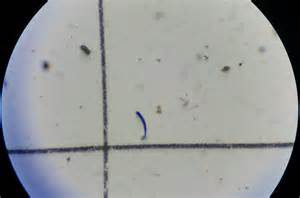
The most common form of microplastic are fibers.
Photo: UF IFAS St. Johns County
Another problem are the toxic compounds already in seawater. Compounds such as PCBs, PAHs, and DDT. It has been found that these compounds adhere to microplastics. Thus, if marine organisms consume (or accidentally ingest) these microplastics, the concentrations of these toxins are higher than they would be if the microplastics were not present.
Studies have shown:
– Pacific oysters had decreased egg production and sperm motility, fewer larvae survived, and the survivors grew more slowly than those in the control population.
– Plastic leachate impaired development of brown mussel larvae.
– Shore crabs fed microplastics consumed less food over time.
A recent summer research project at the University of West Florida found microplastics within the gut and tissues of all seafood products purchased in local seafood markets. And recently a study of human stool samples from volunteers in Europe and Japan found microplastics in us. Again, we are not sure of the impact on our health from this, but they are there.
So, what do we do?
One idea is to remove these microplastics from the ocean – skimming or filtering somehow. As you might guess, this also removes much needed phytoplankton and zooplankton.
There is the ole “Recycle, Reuse, Reduce” idea we learned when we were in school. Unfortunately, recycling plastic has not been working well. Being a petroleum product, the price of oil can dictate the price of recycled plastic. With low oil prices comes low recycling profits. In many cases it can be cheaper to produce and purchase new plastic products. Also, unlike glass, plastic can only be recycled so many times.
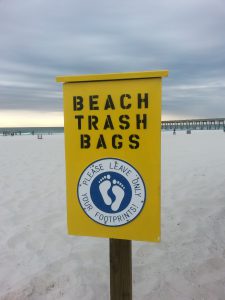
Boxes providing garbage bags and disposal.
Photo: Pensacola Beach Advocates
Reuse and reduce may be the better options. If you must purchase plastic items, try to reuse them. In many cases this is difficult and the reduce method is the better option. Reduce the purchase of plastic items such as your own drinking container instead of using the one-time plastic cup at meetings or events. And of course, reusable grocery bags. You will have to think on how to reduce some items, but most can be done.
There are numerous more suggestions, and more information, on Dr. Maia McGuire’s Flagler County Extension website – http://sfyl.ifas.ufl.edu/flagler/marine-and-coastal/microplastics/.
Help make others more aware of microplastics during Microplastics Awareness Month.

by Rick O'Connor | May 17, 2019
I am writing about this animal because, though it is rare to see them, our terrapin volunteers saw two this past week; and maybe you will too.
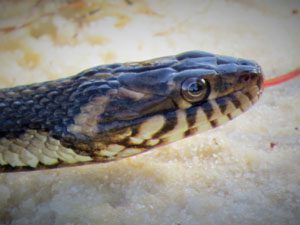
The round pupil and vertical jaw stripes indicate this is the nonvenomous Nerodia. Photo: Carole Tebay
The Gulf salt marsh snake is one of those, like the eastern coral snake, that is actually common – just rare to see. It is rare to see because (a) it lives in muddy salt marshes, where we rarely venture, and (b) it is mostly nocturnal – and even fewer of us venture into muddy salt marshes at night.
It is in the genus Nerodia, which includes the common water snakes like the banded water snake (Nerodia fasicata). It is a harmless nonvenomous snake. However, because of where it lives, it is often confused with a cottonmouth and is killed. A common name for this snake in Alabama is “bay moccasin”.
Their name is Nerodia clarkii, but it is a subspecies of this group – so the actual name is Nerodia clarkii clarkii. The other two subspecies are found in Florida. The Mangrove salt marsh snake (Nerodia clarkii compressicauda) is found from central Gulf coast of Florida, around the Keys to Indian River County on the Atlantic coast. The Atlantic salt marsh snake (Nerodia clarkii taeniata) has a very small range. Originally reported in Volusia, Brevard, and Indian River counties – due to the northern expansion of mangroves, it is believed to only be in Volusia County now. It is listed as THREATENED both federally and with the state. Our Gulf salt marsh snake is found from central Florida to Texas.
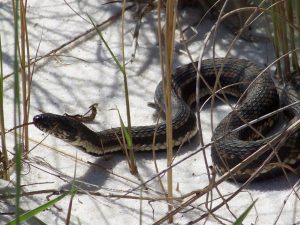
The nonvenomous Gulf Salt marsh Snake.
Photo: Molly O’Connor
It is a relatively small snake, only reaching a length of around 15-20 inches, though some have been reported at 30 inches. They possess two long yellowish-tan stripes running laterally the length of its body, the only species of Nerodia to do so. Again, they move at night feeding on small crabs, shrimp, frogs, and small fish. During daylight hours they hide beneath the wrack or other vegetation avoiding herons, egrets, and larger blue crabs. Lacking the needed glands, they cannot desalinate seawater the way sea turtles and terrapins can. All of their freshwater comes from their food and from rainfall.
They breed in the spring, possibly why we are seeing them now, and give live birth to about 10 young in midsummer. They are of moderate conservation concern in Alabama due to the loss of salt marsh. The loss of salt marsh habitat and rise of sea level are their major concerns at this point.
I do need to warn you, though it is a small, nonvenomous snake, they will bite. If bitten, soap and water will do the job. For me, and others, it is actually exciting to see them because of their reclusive nature. If you see one while exploring our intracoastal waters, know that you are not in any danger but rather lucky to see this “mystery of the marsh”.
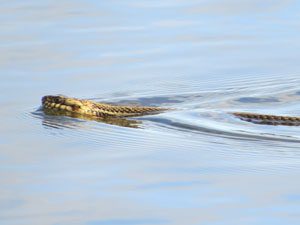
The Gulf Salt Marsh Snake swimming in a local marsh.
Photo: Carole Tebay
References
Gulf Salt Marsh Snake – Texas Parks and Recreation – https://tpwd.texas.gov/huntwild/wild/species/gulfsnake/.
iNaturalist – https://www.inaturalist.org/guide_taxa/776612.
Outdoor Alabama – Alabama Department of Conservation and Natural Resources – https://www.outdooralabama.com/non-venomous-snakes/gulf-saltmarsh-snake.
Atlantic Salt Marsh Snake – N.c.taeniata – U.S. Fish and Wildlife – https://www.fws.gov/northflorida/Species-Accounts/Atl-Salt-Marsh-Snake-2005.htm.
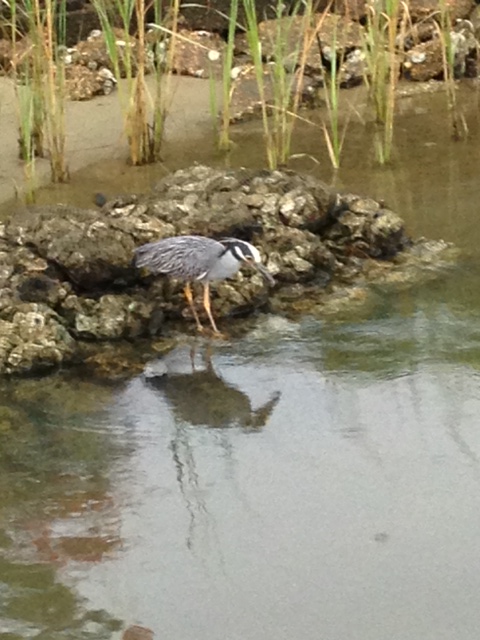
by Rick O'Connor | Apr 18, 2019
Oysters are like snakes… you either like them or you hate them. You rarely hear someone say – “yea, their okay”. It’s either I can’t get enough of them, or they are the most disgusting thing in the sea.
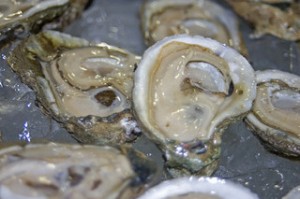
Courtesy of Florida Sea Grant
That said, they are part of our culture. Growing up here in the Florida panhandle, there were oyster houses everywhere. They are as common on menus as French fries or coleslaw. Some like them raw, some like them in gumbo or stews, others are fried oyster fans. But whether you eat them or not, you are aware of them. They are part of being in the northern Gulf of Mexico.
In recent decades the historic oyster beds that supported so many families over the years have declined in production. There are a variety of stressors triggering this. Increased sedimentation, decreased salinity, overharvesting, not returning old shell to produce new reefs, and many more. The capitol of northwest Florida’s oyster coast is Apalachicola. Many are aware of the decline of harvest there. Certainly, impacted by the “water wars” between our state and Georgia, there are other reasons why this fishery has declined. I had a recent conversation with a local in Apalachicola who mentioned they had one of their worst harvest on record this past year. Things are really bad there.
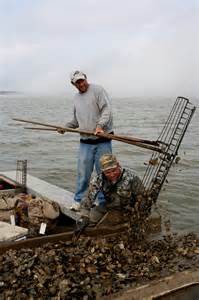
An oysterman uses his 11 foot long tongs to collect oysters from the bottom of Apalachicola Bay
Photo: Sea Grant
Despite the loss of oysters and oyster habitat, there has not been a decline in the demand for them at local restaurants. There have been efforts by Florida Sea Grant and others to help restore the historic beds, improve water quality, and assist some with the culture of oysters in the panhandle.
Enter the Bream Fisherman’s Association of Pensacola.
This group has been together for a long time and have worked hard to educate and monitor our local waterways. In 2018 they worked with a local oyster grower and the University of West Florida’s Center for Environmental Diagnostics and Bioremediation to develop an oyster garden project called Project Oyster Pensacola. Volunteers were recruited to purchase needed supplies and grow young oysters in cages hanging from their docks. Participants lived on Perdido, Blackwater, East, and Escambia Bays. Bayous Texar, and Grande. As well as Big Lagoon and Santa Rosa Sound. The small, young oysters (spat) were provided by the Pensacola Bay Oyster Company. The volunteers would measure spat growth over an eight-month period beginning in the spring of 2018. In addition, they collected data on temperature, salinity, and dissolved oxygen at their location.
After the first year, the data suggests where the salinity was higher, the oysters grew better. Actually, low salinity proved to be lethal to many of them. This is a bit concerning when considering the increase rainfall our community has witnessed over the last two years. Despite an interest in doing so, the volunteers were not allowed to keep their oysters for consumption. Permits required that the oysters be placed on permitted living shoreline projects throughout the Pensacola Bay area.
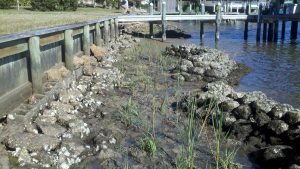
Oyster bags used in a bulkhead restoration project.
Photo: Florida Department of Environmental Protection
We all know how important oysters are to the commercial seafood industry, but it turns out they are as important to the overall health to the bays ecology. A single oyster has been reported to filter as much as 50 gallons of seawater an hour. This removes sediments and provides improved water clarity for the growth of seagrasses. It has been estimated that seagrasses are vital to at least 80% of the commercially important seafood species. It is well known that seagrasses and salt marshes are full of life. However, studies show that biodiversity and biological production are actually higher in oyster reefs. Again, supporting a booming local recreational fishing industry.
This project proved to be very interesting in it’s first year. BFA will be publishing a final report soon and plan to do a second round. For the oyster lovers in the area, increasing local oysters would be nothing short of wonderful.


 to show you support bird conservation, please send an email to: chrismv@ufl.edu, Please put “chick magnet” in the subject line. Please allow 2 weeks to receive your magnet in the mail. Limited quantities available.
to show you support bird conservation, please send an email to: chrismv@ufl.edu, Please put “chick magnet” in the subject line. Please allow 2 weeks to receive your magnet in the mail. Limited quantities available.

























